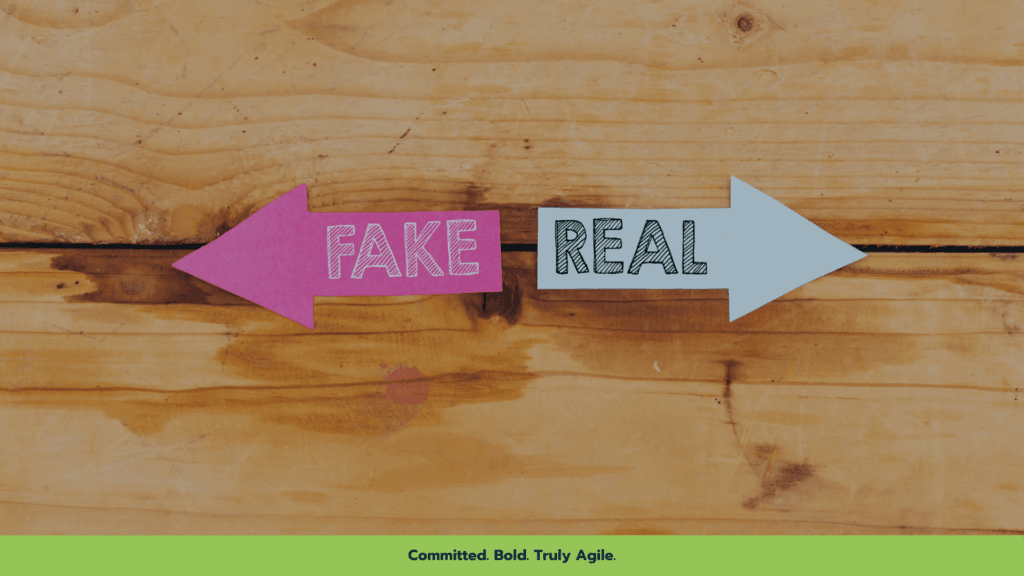Agile methodology has become the gold standard for many teams in today’s business environment, bringing flexibility, transparency, and a faster response to change. However, many organizations fall into the “fake agile” trap—superficially applying Agile practices without genuinely embracing Agile’s core values and principles.
“Fake Agile” refers to situations where an organization or team appears to be using Agile methods but only on the surface. There are meetings, notes, and even retrospectives, but the essential agility – a culture of continuous improvement, adaptation, and a focus on customer value – is often missing. Fake Agile resembles a facade that looks appealing from the outside but lacks stability and is hollow within.
How to Recognize “Fake Agile”?
Many organizations seek quick results and adopt Agile methodology but only on a surface level, without a deeper understanding of its core principles and values. This approach often leads to teams and processes appearing Agile externally while lacking real agility, flexibility, and a culture of adaptation. It’s essential to recognize the differences between genuine and superficial Agile, which can help organizations avoid the trap of formality without real impact.
Some of the most common signs of superficial Agile methodology include:
- Meetings without purpose: Teams spend time in daily meetings, sprint planning, and retrospectives, but these often serve as mere formalities.
- Micromanagement instead of empowerment: In a truly Agile environment, teams are empowered to make decisions. Fake Agile, however, maintains strict hierarchy and controls, often turning meetings into opportunities for micromanagement, which contradicts the spirit of Agile.
- Nonexistent or neglected retrospectives: Retrospectives are crucial for continuous improvement, but when held only as a formality, without real actions to drive change, it indicates a fake Agile approach.
- Focus on deadlines and output, not value: Fake Agile often adheres to a traditional approach where deadlines and output take priority, while customer value is secondary. True Agile is focused on value and iterative learning, not just the amount of work done.
- Rigid Procedures Without Adaptation: True Agile involves adapting processes to the specific needs of the team and project. Fake Agile, on the other hand, clings to rigid rules and procedures, without room for adaptation.
Why is “Fake Agile” a problem?
“Fake Agile” can create serious challenges that negatively impact teams, the organization, and end users. When Agile is applied superficially, trust in its real value is quickly lost. Teams and management soon begin to doubt the effectiveness of Agile methodology, leading to resistance against further transformation efforts. This experience can make Agile an undesirable approach, especially due to the lack of tangible benefits.
In addition to eroding trust, fake Agile often undermines team efficiency and morale. Without genuine benefits such as empowerment and transparency, team members feel frustrated, directly affecting their engagement and performance. This diminishes Agile’s potential to provide a flexible and efficient way of working.
Furthermore, instead of fostering innovation, fake Agile creates an environment where changes are difficult to implement, limiting opportunities for adaptation and product improvement. Experimentation, a key aspect of true Agile, often becomes secondary, stifling the team’s creative processes.
Superficial Agile methodology represents a missed opportunity for genuine improvement. True Agile enables teams to continuously learn, grow, and adapt, while fake Agile slows that process, leaving the company stagnant. Without room for evolution, the organization remains locked into a static approach.
How to overcome “Fake Agile”?
Overcoming fake Agile and transitioning to a true Agile methodology requires commitment and effort to change the team’s culture and processes. The first step is education – investing in training on true Agile principles and values so that teams understand not only how but also why they are applying certain practices.
A focus on retrospectives also plays a key role: retrospectives should lead to specific actions that drive real changes, with their impact regularly measured. Empowering teams and granting them autonomy to make decisions helps create a truly Agile environment. Instead of rigid rules, allow teams to adapt processes to meet the needs of the project and market, with customer value as the central guide.
True Agile brings benefits such as more efficient teams, better products, and happier customers, but it requires authenticity and a continuous commitment to development. Real progress begins only when fake Agile is set aside, and authentic Agile principles become the foundation of daily work.


